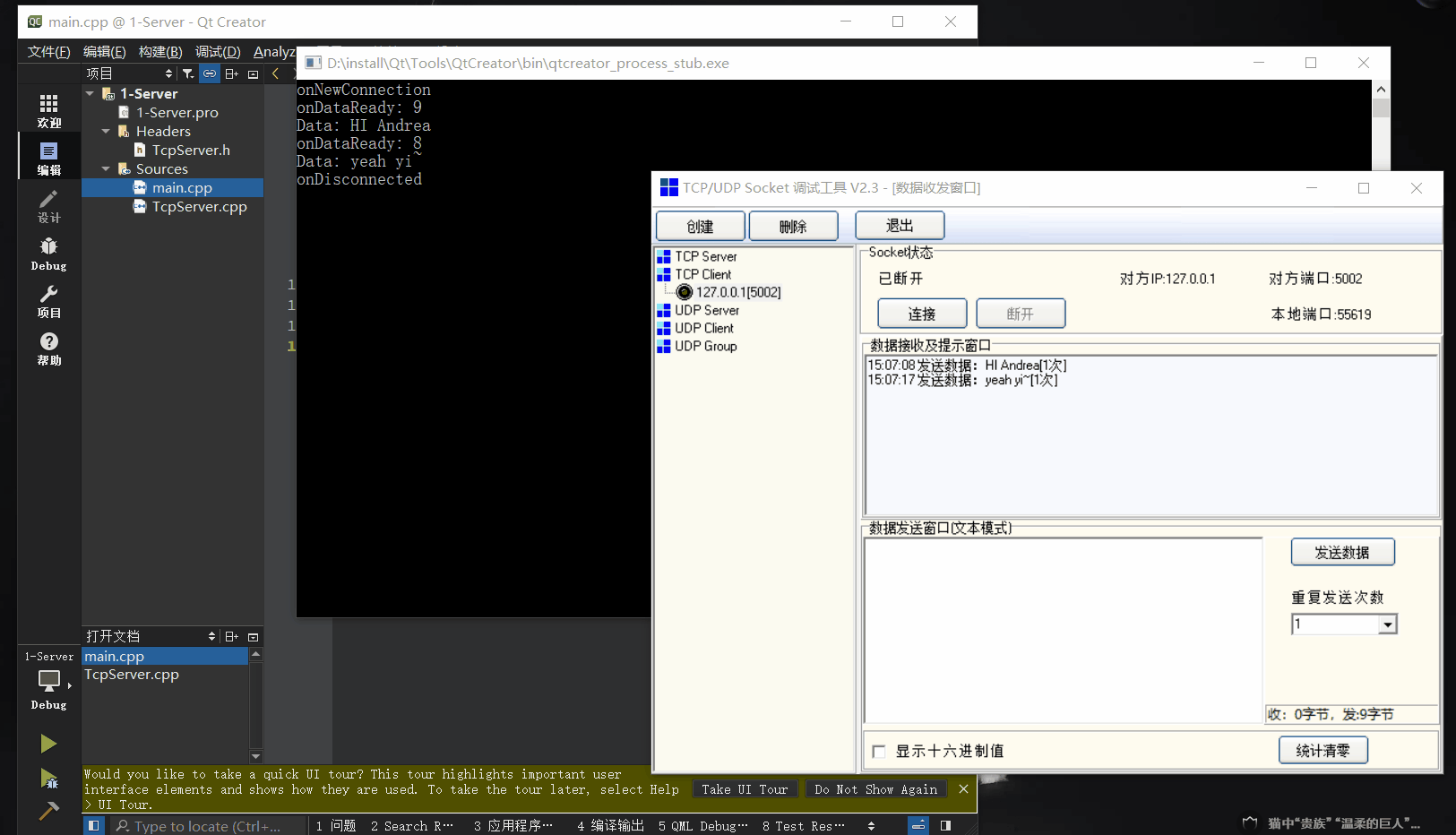一. socket
-
socket抽象层
socket抽象层以下包括socket抽象层都是操作系统封装好的
除非你是系统开发工程师,所以一般的软件开发工程都是使用socket提供的接口结合应用层的协议开发应用程序,常见的应用层协议像是HTTP、HTTPS用于web开发,MQTT用于物联网设备间的通信
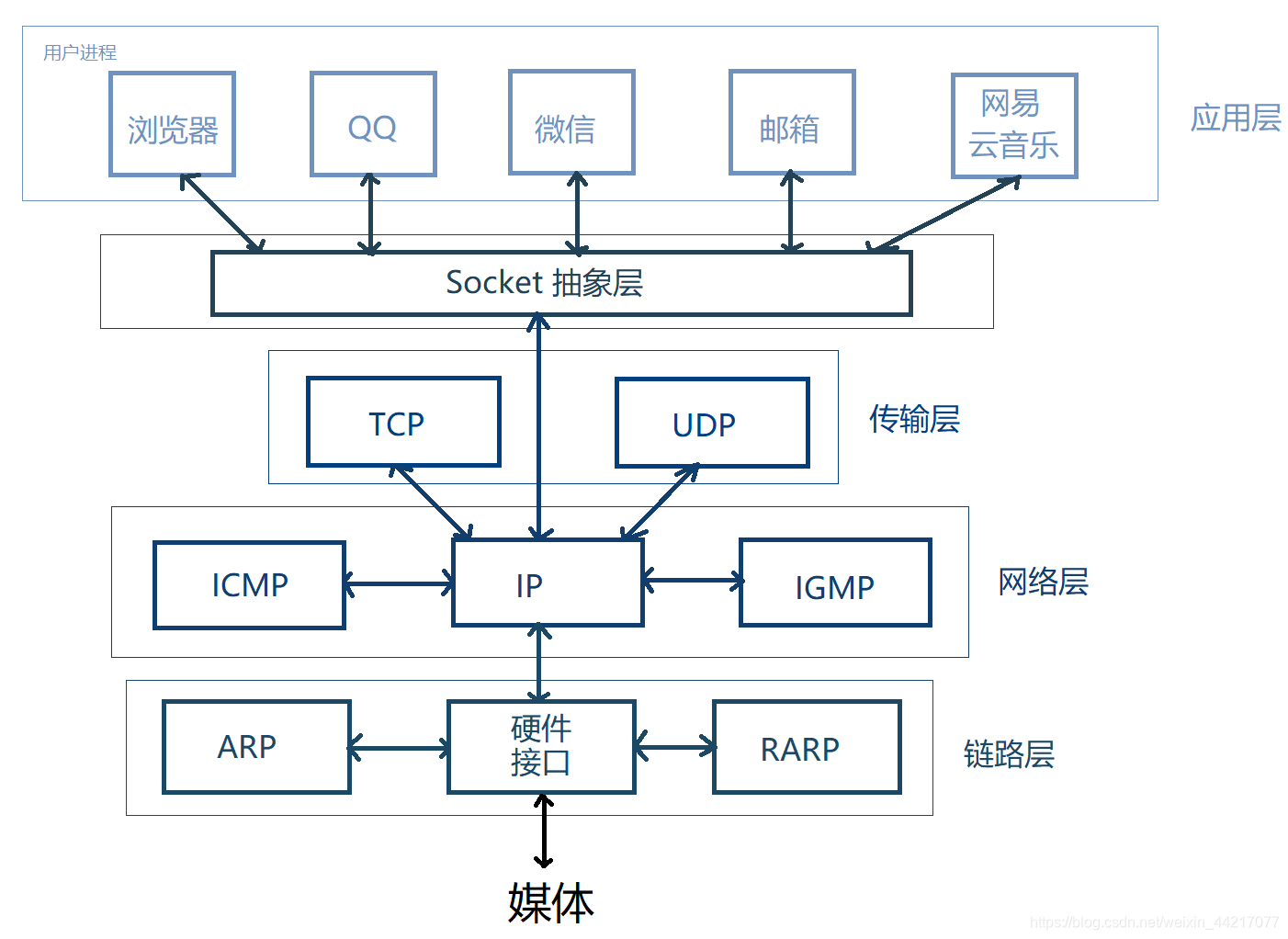
二. Qt中的TCP通信实现
2.1 网络相关的类
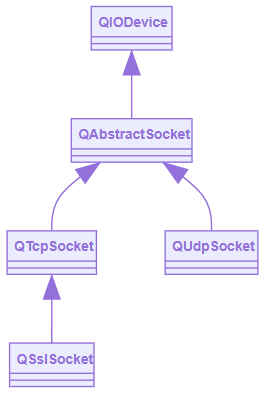
2.2 Qt中的TCP客户端编程
-
对于QTcpSocket可以看成一种Qt中的IO设备,按照常规的IO操作方式读写网络数据即可

-
QTcpSocket的使用方法
connectToHost() //连接服务器 write()/read() //发送数据/接收数据 close() //关闭连接 -
同步编程的方式,即面向过程的编程方式

-
代码实现
QTcpSocket client; char buf[256] = {0}; client.connectToHost("127.0.0.1", 8080); //要连接的服务器的IP地址和端口号 qDebug() << "Connected:" << client.waitForConnected(); //发送连接请求, while(1){ qDebug() << "Send Bytes:" << client.write("ALoHa Andrea"); //向写缓冲写入字符串 qDebug() << "Send Status:" << client.waitForBytesWritten();//等待数据发送完毕 qDebug() << "Data Available:" << client.waitForReadyRead();//等待读取读缓冲区服务器发送来的数据 qDebug() << "Received Bytes:" << client.read(buf, sizeof(buf)-1);//将服务器发送来的数据读取到buf中 qDebug() << "Received Data:" << buf; //打印读取到的字符串 } client.close(); // client.waitForDisconnected(); -
实验现象
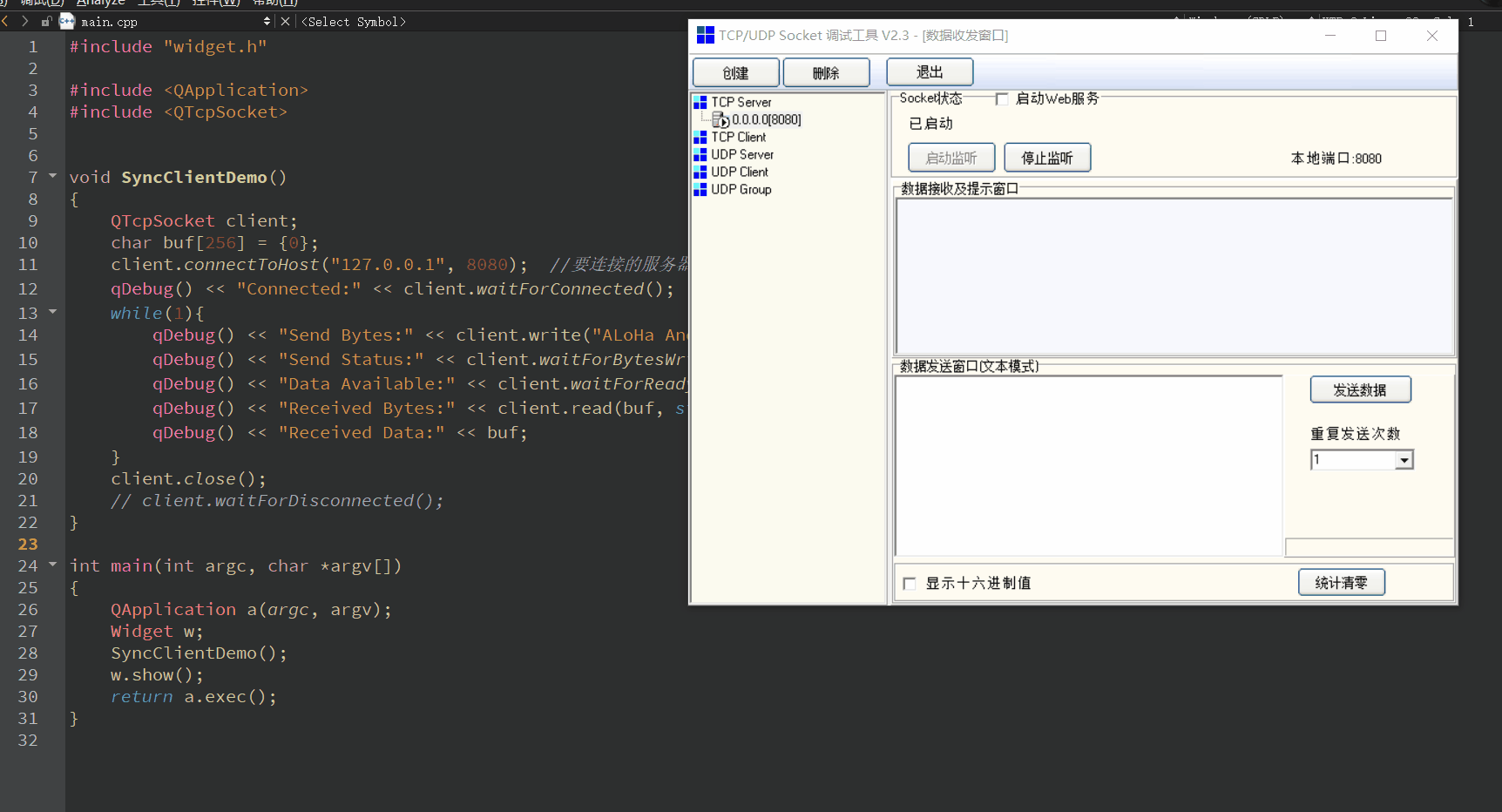
2.3 使用面向对象的思想实现TCP客户端
-
关键的信号
connected() :成功连接服务器 disconnected():远端主机段考连接 readyRead():远端数据到达本机 bytesWritten(qint64):数据成功发送至系统 -
代码
#ifndef CLIENT_H #define CLIENT_H #include <QObject> #include <QTcpSocket> class ClientDemo : public QObject { Q_OBJECT QTcpSocket m_client; //定义一个套接字对象 protected slots: void onConnected(); //连接成功后槽函数 void onDisconnected(); //无法连接主机 void onDataReady(); //接收对方传来的数据 void onBytesWritten(qint64 bytes);// 发送数据 public: ClientDemo(QObject* parent = NULL); void connectTo(QString ip, int port); qint64 send(const char* data, int len); qint64 available(); void close(); }; #endif // CLIENT_H#include "Client.h" #include <QHostAddress> #include <QDebug> ClientDemo::ClientDemo(QObject* parent) : QObject(parent) { //构造函数中 连接信号和槽 connect(&m_client, SIGNAL(connected()), this, SLOT(onConnected())); connect(&m_client, SIGNAL(disconnected()), this, SLOT(onDisconnected())); connect(&m_client, SIGNAL(readyRead()), this, SLOT(onDataReady())); connect(&m_client, SIGNAL(bytesWritten(qint64)), this, SLOT(onBytesWritten(qint64))); } //连接成功后,打印主机地址和端口号 void ClientDemo::onConnected() { qDebug() << "onConnected"; qDebug() << "Local Address:" << m_client.localAddress(); qDebug() << "Local Port:" << m_client.localPort(); } //无法连接打印异常语句 void ClientDemo::onDisconnected() { qDebug() << "onDisconnected"; } //打印获取到的数据 void ClientDemo::onDataReady() { char buf[256] = {0}; qDebug() << "onDataReady:" << m_client.read(buf, sizeof(buf)-1); qDebug() << "Data:" << buf; } //发送数据 void ClientDemo::onBytesWritten(qint64 bytes) { qDebug() << "onBytesWritten:" << bytes; } void ClientDemo::connectTo(QString ip, int port) { m_client.connectToHost(ip, port); } qint64 ClientDemo::send(const char* data, int len) { return m_client.write(data, len); } qint64 ClientDemo::available() { return m_client.bytesAvailable(); } void ClientDemo::close() { m_client.close(); }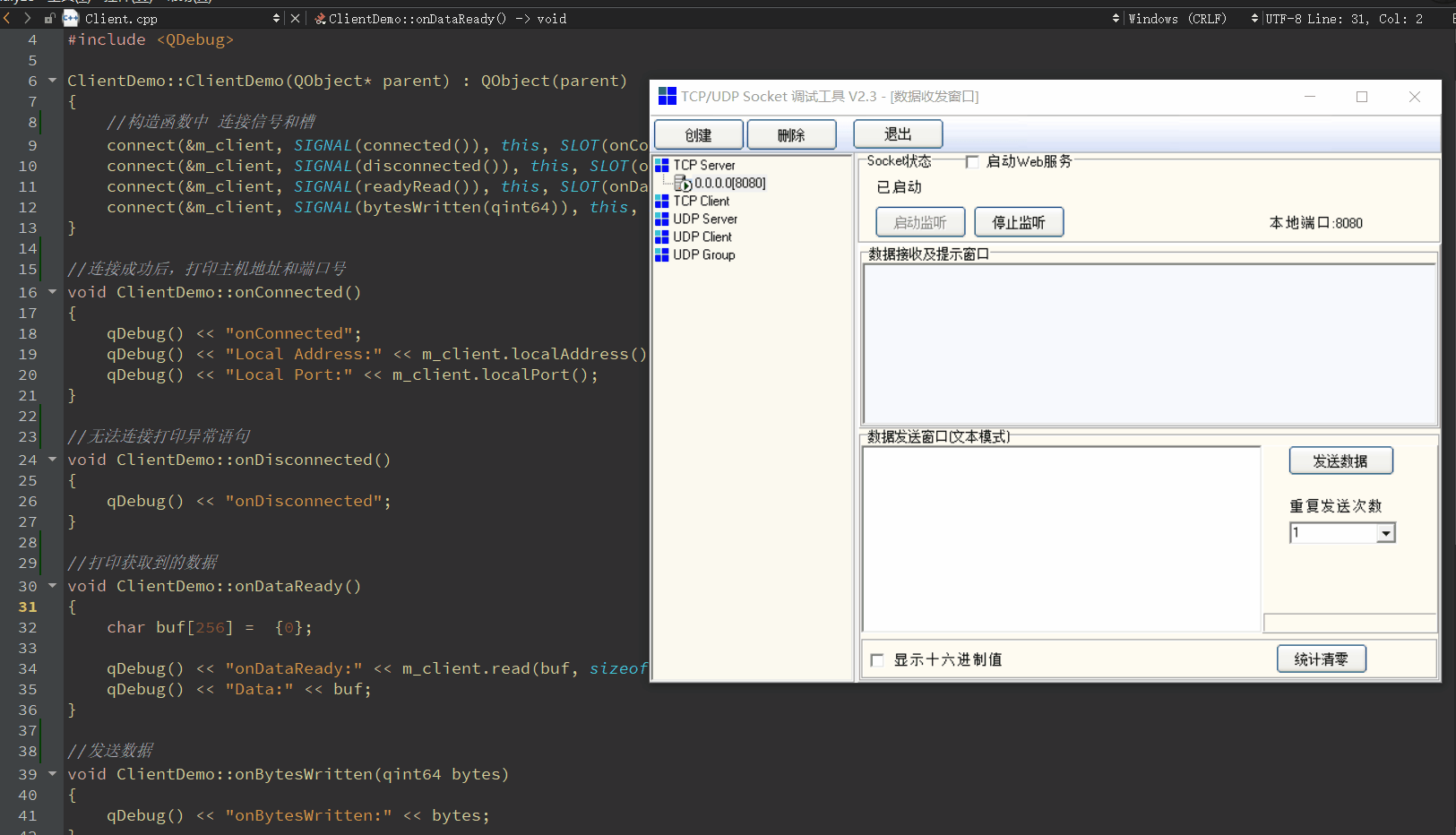
2.4 TCP服务器的实现
-
服务器的概念
服务器端是为客户端提供服务的,服务的内容诸如向客户端提供资源,保存客户端数据,为客户端提供功能接口等
-
C/S架构
服务端被动接受连接(服务端无法主动连接客户端)
服务端必须公开网络地址(容易受到攻击)
在职责上:客户端倾向于处理用户交互及体验(GUI)
在职责上:服务器倾向于用户数据的组织和存储(数据处理)
-
B/S架构
是一种特殊的C/S网络架构
B/S中的客户端统一使用浏览器(意味着不用安装客户端,只要有浏览器就可以访问服务器)
B/S中的客户端GUI通常采用HTML进行开发
B/S中的客户端与服务端通常采用http协议进行通信
-
Qt中的TCP服务端使用的类(QTcpServer)
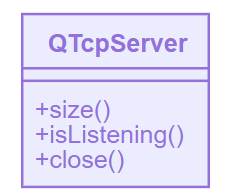
-
QTcpServer使用方式
listen() //监听本机地址的端口 newConnection() //通过信号通知客户端连接 nextPendingConnection()//获取QTcpSocket通信对象 close() //停止监听 -
QTcpServer使用的注意事项
QTcpServer对象不具备通信的能力,它就像一个前台,当有客户端申请连接,会生成一个QTcpSocket对象与客户端进行通信,这个过程类似于Linux下accep()函数的返回值
-
Client/Server交互流程

-
代码
#ifndef SERVERDEMO_H #define SERVERDEMO_H #include <QObject> #include <QTcpServer> class ServerDemo : public QObject { Q_OBJECT QTcpServer m_server; public: ServerDemo(QObject* parent = NULL); bool start(int port); void stop(); ~ServerDemo(); protected slots: void onNewConnection(); void onConnected(); void onDisconnected(); void onDataReady(); void onBytesWritten(qint64 bytes); }; #endif // SERVERDEMO_H#include "TcpServer.h" #include <QHostAddress> #include <QTcpSocket> #include <QObjectList> #include <QDebug> ServerDemo::ServerDemo(QObject* parent) : QObject(parent) { connect(&m_server, SIGNAL(newConnection()), this, SLOT(onNewConnection())); } void ServerDemo::onNewConnection() { qDebug() << "onNewConnection"; QTcpSocket* tcp = m_server.nextPendingConnection(); connect(tcp, SIGNAL(connected()), this, SLOT(onConnected())); connect(tcp, SIGNAL(disconnected()), this, SLOT(onDisconnected())); connect(tcp, SIGNAL(readyRead()), this, SLOT(onDataReady())); connect(tcp, SIGNAL(bytesWritten(qint64)), this, SLOT(onBytesWritten(qint64))); } void ServerDemo::onConnected() { QTcpSocket* tcp = dynamic_cast<QTcpSocket*>(sender()); if( tcp != NULL ) { qDebug() << "onConnected"; qDebug() << "Local Address:" << tcp->localAddress(); qDebug() << "Local Port:" << tcp->localPort(); } } void ServerDemo::onDisconnected() { qDebug() << "onDisconnected"; } void ServerDemo::onDataReady() { QTcpSocket* tcp = dynamic_cast<QTcpSocket*>(sender()); char buf[256] = {0}; if( tcp != NULL ) { qDebug() << "onDataReady:" << tcp->read(buf, sizeof(buf)-1); qDebug() << "Data:" << buf; } } void ServerDemo::onBytesWritten(qint64 bytes) { qDebug() << "onBytesWritten:" << bytes; } bool ServerDemo::start(int port) { bool ret = true; if( !m_server.isListening() ) { ret = m_server.listen(QHostAddress("127.0.0.1"), port); } return ret; } void ServerDemo::stop() { if( m_server.isListening() ) { m_server.close(); } } ServerDemo::~ServerDemo() { const QObjectList& list = m_server.children(); for(int i=0; i<list.length(); i++) { QTcpSocket* tcp = dynamic_cast<QTcpSocket*>(list[i]); if( tcp != NULL ) { tcp->close(); } } } -
实现效果
